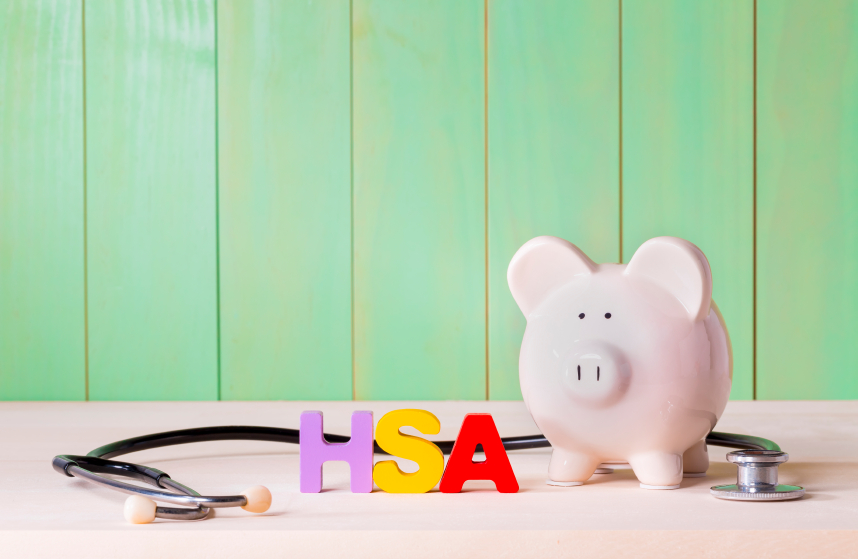
by admin | Mar 14, 2018 | ACA, HSA/HRA, IRS

Taking control of health care expenses is on the top of most people’s to-do list for 2018. The average premium increase for 2018 is 18% for Affordable Care Act (ACA) plans. So, how do you save money on health care when the costs seems to keep increasing faster than wage increases? One way is through medical savings accounts.
Medical savings accounts are used in conjunction with High Deductible Health Plans (HDHP) and allow savers to use their pre-tax dollars to pay for qualified health care expenses. There are three major types of medical savings accounts as defined by the IRS. The Health Savings Account (HSA) is funded through an employer and is usually part of a salary reduction agreement. The employer establishes this account and contributes toward it through payroll deductions. The employee uses the balance to pay for qualified health care costs. Money in HSA is not forfeited at the end of the year if the employee does not use it. The Health Flexible Savings Account (FSA) can be funded by the employer, employee, or any other contributor. These pre-tax dollars are not part of a salary reduction plan and can be used for approved health care expenses. Money in this account can be rolled over by one of two ways: 1) balance used in first 2.5 months of new year or 2) up to $500 rolled over to new year. The third type of savings account is the Health Reimbursement Arrangement (HRA). This account may only be contributed to by the employer and is not included in the employee’s income. The employee then uses these contributions to pay for qualified medical expenses and the unused funds can be rolled over year to year.
There are many benefits to participating in a medical savings account. One major benefit is the control it gives to employee when paying for health care. As we move to a more consumer driven health plan arrangement, the individual can make informed choices on their medical expenses. They can “shop around” to get better pricing on everything from MRIs to prescription drugs. By placing the control of the funds back in the employee’s hands, the employer also sees a cost savings. Reduction in premiums as well as administrative costs are attractive to employers as they look to set up these accounts for their workforce. The ability to set aside funds pre-tax is advantageous to the savings savvy individual. The interest earned on these accounts is also tax-free.
The federal government made adjustments to contribution limits for medical savings accounts for 2018. For an individual purchasing single medical coverage, the yearly limit increased $50 from 2017 to a new total $3450. Family contribution limits also increased to $6850 for this year. Those over the age of 55 with single medical plans are now allowed to contribute $4450 and for families with the insurance provider over 55 the new limit is $7900.
Health care consumers can find ways to save money even as the cost of medical care increases. Contributing to health savings accounts benefits both the employee as well as the employer with cost savings on premiums and better informed choices on where to spend those medical dollars. The savings gained on these accounts even end up rewarding the consumer for making healthier lifestyle choices with lower out-of-pocket expenses for medical care. That’s a win-win for the healthy consumer!

by admin | Mar 9, 2018 | HSA/HRA, IRS
 On March 5, 2018, the Internal Revenue Service (IRS) announced a reduction in the maximum annual contribution allowed for Health Savings Accounts (HSAs) in 2018. The change does not affect people whose HSA contributions are based on self-only health coverage, but it does affect those with family coverage under a qualifying High Deductible Health Plan (HDHP). Previously, the 2018 HSA contribution limit for persons with family HDHP coverage was $6,900. That limit is now reduced retroactively to $6,850.
On March 5, 2018, the Internal Revenue Service (IRS) announced a reduction in the maximum annual contribution allowed for Health Savings Accounts (HSAs) in 2018. The change does not affect people whose HSA contributions are based on self-only health coverage, but it does affect those with family coverage under a qualifying High Deductible Health Plan (HDHP). Previously, the 2018 HSA contribution limit for persons with family HDHP coverage was $6,900. That limit is now reduced retroactively to $6,850.
In Revenue Bulletin 2018-10, the IRS explains that the recently-enacted tax reform law requires recalculating inflation-adjusted amounts under various tax code provisions. One of the affected provisions is § 223 pertaining to HSAs. Using the new required method of applying annual inflation adjustments, the 2018 HSA contribution limit for those with family HDHP coverage is $6,850, which is a $50 reduction from the amount previously announced.
HSA Summary
An HSA is a tax-exempt savings account employees can use to pay for qualified health expenses. To be eligible to contribute to an HSA, an employee:
- Must be covered by a qualified high deductible health plan (HDHP);
- Must not have any disqualifying health coverage (called “impermissible non-HDHP coverage”);
- Must not be enrolled in Medicare; and
- May not be claimed as a dependent on someone else’s tax return.
HSA 2018 Limits
Limits apply to HSAs based on whether an individual has self-only or family coverage under the qualifying HDHP.
2018 HSA contribution limit:
- Single: $3,450
- Family: $6,850
- Catch-up contributions for those age 55 and older remains at $1,000
2018 HDHP minimum deductible (not applicable to preventive services):
- Single: $1,350
- Family: $2,700
2018 HDHP maximum out-of-pocket limit:
- Single: $6,650
- Family: $13,300*
*If the HDHP is a nongrandfathered plan, a per-person limit of $7,350 also will apply due to the ACA’s cost-sharing provision for essential health benefits.
Originally Published By ThinkHR.com

by admin | Mar 5, 2018 | Health & Wellness, Human Resources
 This year’s flu season is a rough one. Although the predominant strains of this year’s influenza viruses were represented in the vaccine, they mutated, which decreased the effectiveness of the immunization. The flu then spread widely and quickly, and in addition, the symptoms were severe and deadly. The U.S. Centers for Disease Control and Prevention (CDC) reported that the 2017 – 2018 flu season established new records for the percentage of outpatient visits related to flu symptoms and number of flu hospitalizations.
This year’s flu season is a rough one. Although the predominant strains of this year’s influenza viruses were represented in the vaccine, they mutated, which decreased the effectiveness of the immunization. The flu then spread widely and quickly, and in addition, the symptoms were severe and deadly. The U.S. Centers for Disease Control and Prevention (CDC) reported that the 2017 – 2018 flu season established new records for the percentage of outpatient visits related to flu symptoms and number of flu hospitalizations.
Younger, healthy adults were hit harder than is typical, which had impacts on the workplace. In fact, Challenger, Gray & Christmas, Inc. recently revised its estimates on the impact of this flu season on employers, raising the cost of lost productivity to over $21 billion, with roughly 25 million workers falling ill.
Fortunately, the CDC is reporting that it looks like this season is starting to peak, and while rates of infection are still high in most of the country, they are no longer rising and should start to drop. What can you do as an employer to keep your business running smoothly for the rest of this flu season and throughout the next one?
- Help sick employees stay home. Consider that sick employees worried about their pay, unfinished projects and deadlines, or compliance with the company attendance policy may feel they need to come to work even if they are sick. Do what you can to be compassionate and encourage them to stay home so they can get better as well as protect their co-workers from infection. In addition, make sure your sick leave policies are compliant with all local and state laws, and communicate them to your employees. Be clear with the expectation that sick employees not to report to work. For employees who feel well enough to work but may still be contagious, encourage them to work remotely if their job duties will allow. Be consistent in your application of your attendance and remote work rules.
- Know the law. Although the flu is generally not serious enough to require leaves of absence beyond what sick leave or PTO allow for, in a severe season, employees may need additional time off. Consider how the federal Family and Medical Leave Act (FMLA), state leave laws, and the Americans with Disabilities Act (ADA) may come into play for employees who have severe cases of the flu, complications, or family members who need care.
- Be flexible. During acute flu outbreaks, schools or daycare facilities may close, leaving parents without childcare. Employees may also need to be away from the workplace to provide care to sick children, partners, or parents. Examine your policies to see where you can provide flexibility. Look for opportunities to cross-train employees on each other’s essential duties so their work can continue while they are out.
- Keep it clean. Direct cleaning crews to thoroughly disinfect high-touch areas such as doorknobs, kitchen areas, and bathrooms nightly. Provide hand sanitizer in common areas and encourage frequent handwashing. Keep disinfecting wipes handy for staff to clean their personal work areas with.
- Limit exposure. Avoid non-essential in-person meetings and travel that can expose employees to the flu virus. Rely on technology such as video conferencing, Slack, Skype, or other platforms to bring people together virtually. Consider staggering work shifts if possible to limit the number of people in the workplace at one time.
- Focus on wellness. Offer free or low-cost flu shots in the workplace. If your company provides snacks or meals for employees, offer healthier options packed with nutrients.
Get it all
AGENCY RESOURCES: Get the latest weekly flu stats from the CDC. Learn more about how the FMLA and ADA may be used during pandemic flu from the U.S. Department of Labor.
By Rachel Sobel
Originally published by www.ThinkHR.com

by admin | Feb 28, 2018 | Compliance, Human Resources
 Employer Response to Immigration Inspection Notice
Employer Response to Immigration Inspection Notice
In January 2018, the California Department of Labor Standards and Enforcement (DLSE) released its pre-inspection notice, Notice to Employee — Labor Code section 90.2.
Effective January 1, 2018, and except as otherwise required by federal law, California employers must provide notice to current employees of any inspection of I-9 Employment Eligibility Verification forms or other employment records conducted by an immigration agency. This notice is completed by posting the DLSE’s Notice to Employee — Labor Code section 90.2 in the language the employer normally uses to communicate employment-related information to the employee within 72 hours of receiving notice of the inspection.
A copy of the Notice of Inspection of I-9 Employment Eligibility Verification forms, and any accompanying documents, must be posted or given to employees with the DLSE notice.
Originally Published By ThinkHR.com

by admin | Feb 22, 2018 | Hot Topics, Human Resources
 Have you ever heard the proverb “Knowledge is power?” It means that knowledge is more powerful than just physical strength and with knowledge people can produce powerful results. This applies to your annual medical physical as well! The #1 goal of your annual exam is to GAIN KNOWLEDGE. Annual exams offer you and your doctor a baseline for your health as well as being key to detecting early signs of diseases and conditions.
Have you ever heard the proverb “Knowledge is power?” It means that knowledge is more powerful than just physical strength and with knowledge people can produce powerful results. This applies to your annual medical physical as well! The #1 goal of your annual exam is to GAIN KNOWLEDGE. Annual exams offer you and your doctor a baseline for your health as well as being key to detecting early signs of diseases and conditions.
According to Malcom Thalor, MD, “A good general exam should include a comprehensive medical history, family history, lifestyle review, problem-focused physical exam, appropriate screening and diagnostic tests and vaccinations, with time for discussion, assessment and education. And a good health care provider will always focus first and foremost on your health goals.”
Early detection of chronic diseases can save both your personal pocketbook as well as your life! By scheduling AND attending your annual physical, you are able to cut down on medical costs of undiagnosed conditions. Catching a disease early means you are able to attack it early. If you wait until you are exhibiting symptoms or have been symptomatic for a long while, then the disease may be to a stage that is costly to treat. Early detection gives you a jump start on treatments and can reduce your out of pocket expenses.
When you are prepared to speak with your Primary Care Physician (PCP), you can set the agenda for your appointment so that you get all your questions answered as well as your PCP’s questions. Here are some tips for a successful annual physical exam:
- Bring a list of medications you are currently taking—You may even take pictures of the bottles so they can see the strength and how many.
- Have a list of any symptoms you are having ready to discuss.
- Bring the results of any relevant surgeries, tests, and medical procedures
- Share a list of the names and numbers of your other doctors that you see on a regular basis.
- If you have an implanted device (insulin pump, spinal cord stimulator, etc) bring the device card with you.
- Bring a list of questions! Doctors want well informed patients leaving their office. Here are some sample questions you may want to ask:
- What vaccines do I need?
- What health screenings do I need?
- What lifestyle changes do I need to make?
- Am I on the right medications?
Becoming a well-informed patient who follows through on going to their annual exam as well as follows the advice given to them from their physician after asking good questions, will not only save your budget, but it can save your life!






